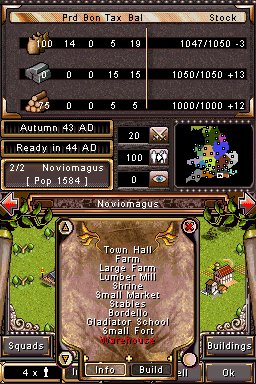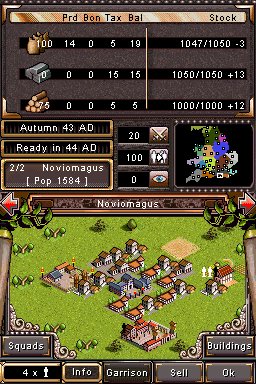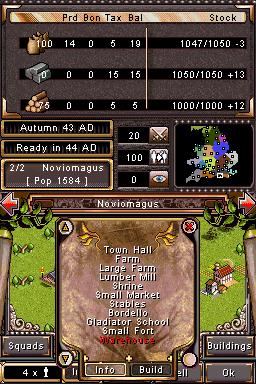GamesRadar+ Verdict
Pros
- +
Lots of buildings to construct
- +
Your troops' funny little names
- +
Learning historical geography
Cons
- -
Watching your armies slowly walk to their deaths
- -
Fights not much to look at
- -
Knowing you're going to win with six hours of play left
Why you can trust GamesRadar+
History Great Empires: Rome is one of those stubbornly historically accurate strategy games. Your troops are named after types of Roman warriors and you can build bathhouses. There’s more, but due to our aversion to learning, we inevitably put our DS down still unsure of the difference between Legionaries and Praetorians. Though in the game, they’re almost functionally identical.

In the six historically accurate campaigns (maps), you’ll face off against something like 20 opponents at a time, each with at least two cities in their territory. Capturing these cities means increased resource production, population and armies; when you get them all it means you win, but that takes awhile. Cities house a limited number of buildings, so you’ll have to choose what you build carefully at first, but there aren’t any terrible choices. Once you control three or four territories, you’ll have no trouble building everything you need.
You can also use diplomacy to form alliances or declare war, but it isn’t terribly necessary to win. The heart of Great Empires: Rome is building an army, marching the troops to a city and wishing them luck as they charge into battle.
Tragically, that really is all you can do for your soldiers. When two armies meet, you’ll deploy your squads before the fighting starts based on limited information on your opponent’s army. Each group gets a formation and a single order, such as advance normally, brief pause and advance or rapidly advance. When the fight starts, you watch as they flounder their way across the map with their singular goals in mind. It’s unskippable and occasionally drags on too long, which wouldn’t be so bad, but chunkily fighting sprites, largely indistinguishable from each other, aren’t very entertaining to watch.

Terrain and formation has an effect on the outcome, but it generally comes down to numbers. If you win you’ll get more resources and if you lose you can rebuild your forces in a few turns, when next Spring comes around. Our main problem with History Great Empires: Rome is that the historic elements are only surface level and the strategy elements aren’t much deeper than that. That’s a big deal for a strategy game, so we’d have a hard time recommending this game for anyone but history buffs – the buffs who don’t mind the historical accuracy of not being able to give your horsemen stuck in the bottom corner of the map real-time orders to go north and kill some undefended archers.
Jun 11, 2009
More info
| Genre | Strategy |
| Description | The first of a series of History Great Empires games, you take the Romans through several very long scenarios. |
| Platform | "DS" |
| US censor rating | "Everyone 10+" |
| UK censor rating | "Rating Pending" |
| Release date | 1 January 1970 (US), 1 January 1970 (UK) |



